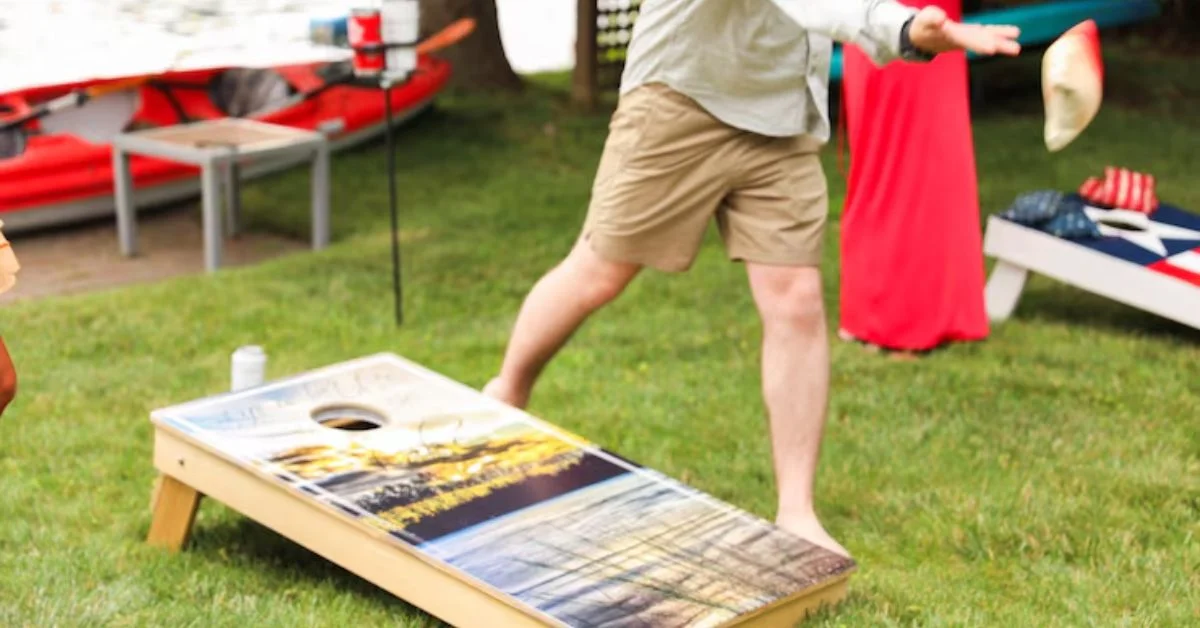Search the phrase “Cornhole Baggo”, and you’ll quickly stumble into a surprisingly deep well of culture, competition, and craftsmanship. At first glance, it might seem like just another lawn game—bean bags, wooden boards, cheers from friends on a summer afternoon. But Cornhole and Baggo, while similar in basic gameplay, represent two distinct evolutions of a popular American pastime, now played everywhere from tailgate parties to national tournaments.
In this article, we’ll answer everything the curious reader—and future champion—wants to know: what Cornhole and Baggo are, how they differ, where they came from, and how both have taken hold in modern American leisure. This is your comprehensive guide to understanding Cornhole Baggo, not just as a game but as a cultural touchstone.
The Searcher’s Intent: What Does “Cornhole Baggo” Mean?
For many, the terms Cornhole and Baggo are used interchangeably, but they are not exactly the same. If you’re searching “Cornhole Baggo,” you’re likely trying to find:
- The difference between the two games
- Rules and scoring systems
- How to play either or both
- What kind of equipment you need
- Whether one is more “official” than the other
Let’s clear the air: both Cornhole and Baggo are bag toss games played on rectangular boards with a hole at the top, but they differ in materials, size, scoring rules, portability, and tradition.
A Brief History: From Grain Sacks to Game Night
Cornhole: A Midwestern Classic
The game commonly known as Cornhole has deep roots in the American Midwest—especially Ohio, Indiana, and Kentucky. While the exact origin is debated, it’s widely accepted that the modern game grew out of agricultural communities, where tossing bags of corn became a form of entertainment.
By the 2000s, Cornhole had surged in popularity at tailgate parties, leading to the formation of leagues and eventually national organizations like the American Cornhole League (ACL).
Cornhole Baggo: A More Portable Spin
Cornhole Baggo, on the other hand, is a branded version of the bag toss game, popularized in the 1990s. Developed with lighter materials (typically plastic boards instead of wood), it was designed for easy transport and storage. It’s often sold as a complete kit with boards, bags, and instructions.
Though the two games are cousins, they’ve developed slightly different cultures: Cornhole as a semi-serious sport, Baggo as a travel-friendly party game.
Game Setup: What You’ll Need
Both Cornhole and Baggo require two boards and eight bags—four for each team.
| Feature | Cornhole | Baggo |
| Board Material | Wood or composite | Lightweight plastic |
| Board Size | 2′ x 4′ regulation size | 2′ x 3′ (typically) |
| Hole Size | 6-inch diameter | 6-inch diameter |
| Distance Apart | 27 feet (regulation) | 21 feet (Baggo rules) |
| Bag Fill | Corn kernels or resin pellets | Often bean or poly fill |
Cornhole Baggo’s plastic boards make it more practical for camping, tailgates, and beach use, while Cornhole boards are heavier and more suited for backyard setups or tournament use.
Gameplay: Rules and Scoring
The objective in both games is the same: toss bags onto the board or into the hole to score points.
Cornhole Rules (Regulation Play)
- Players toss four bags per round, alternating throws.
- Bags on the board = 1 point
- Bags in the hole = 3 points
- Scoring uses cancellation: only the difference in score counts per round.
- First team to 21 points wins.
Baggo Rules (Standard Kit Rules)
- Similar turn-taking: alternate bag tosses.
- Board = 1 point
- Hole = 3 points
- Boards are placed closer (21 feet apart), which changes gameplay dynamics.
- Some Baggo versions allow exact scoring to win (e.g., cannot exceed 21).
Cornhole Baggo’s rules are often more casual and forgiving, making it more accessible for younger players or quick social games.
Culture and Competition
Cornhole: The Professionalization of a Backyard Game
What started as a weekend game has evolved into a legitimate sport. With ESPN broadcasts, national rankings, and sponsorships, Cornhole now hosts tournaments with cash prizes and pro status.
The American Cornhole League (ACL) and American Cornhole Organization (ACO) have codified rules, sponsored players, and even player cards and national championships.
Cornhole players often customize bags for different conditions—slick side, sticky side, fill types—and treat their equipment with the same seriousness as bowlers or darts competitors.
Baggo: Community, Not Competition
Baggo remains rooted in casual play, with most games happening at picnics, campsites, or beach parties. The official Baggo company promotes the game as portable, family-friendly fun.
Players don’t typically modify their equipment or enter leagues. Instead, Baggo thrives on simplicity, portability, and accessibility.
That said, both games share one vital element: fun through friendly competition.
Design and Customization
Cornhole Boards
- Often handcrafted or customized
- Wood grain finishes, team logos, family names
- Heavier but more durable and aesthetic
Baggo Boards
- Lightweight plastic, often with pre-printed graphics
- Foldable legs, built-in bag storage
- Less customization, more grab-and-go
In both communities, bag design has also become important—custom bags with different fabrics, weights, and traction are now common, especially in Cornhole.
Safety and Family Friendliness: Cornhole Baggo
Both games are safe and inclusive, with only minor differences:
- Cornhole’s longer distance and heavier bags make it better suited for adults or older kids.
- Cornhole Baggo’s shorter distance and lighter equipment make it ideal for families with young children or seniors.
No need for helmets—just space, patience, and a sense of humor.
Why the Surge in Popularity?
1. Pandemic Play
During the COVID-19 lockdowns, Cornhole and Baggo became popular for socially distanced outdoor recreation.
2. TV Coverage
Cornhole’s rise as a televised sport (especially during sports downtimes) gave the game national exposure.
3. DIY Culture
Building Cornhole boards became a popular project for woodworkers and hobbyists.
4. Inclusive Fun
No athletic experience required. Anyone can play, from toddlers to retirees.
The Psychological Appeal: Cornhole Baggo
Psychologists might call Cornhole and Baggo examples of “low-friction flow activities”—easy to start, satisfying to improve at, and deeply social.
Unlike high-pressure sports, these games:
- Encourage conversation while playing
- Offer low-stakes competition
- Provide tactile satisfaction with every toss and thunk
- Trigger the human desire for target accuracy
They’re also screen-free, offering a rare moment of analog interaction in an increasingly digital world.
PR Cornhole and Branded Baggo
Major companies have taken notice, too.
- Brands now print custom Cornhole boards for promotions and events.
- Cornhole Baggo kits are given as corporate gifts and team-building tools.
Whether for a family reunion or a Super Bowl party, branded Cornhole and Baggo kits have become merchandising hits—another reason these games aren’t fading anytime soon.
Choosing Which Game Is Right for You
| Use Case | Best Option |
| Backyard tournaments | Cornhole |
| Camping trips and travel | Baggo |
| Custom home-built projects | Cornhole |
| Family picnics with kids | Baggo |
| Aspiring competitive players | Cornhole |
| Simple social fun | Either |
Conclusion: Cornhole and Baggo—Games That Stick
Whether you’re team Cornhole or team Baggo, the essence is the same: a timeless toss game that brings people together. One might be tailored for tournaments and televised matches, the other for easy travel and instant fun—but both are built on the same foundation of connection, simplicity, and satisfaction.
In an age of complex entertainment and screen saturation, the success of Cornhole and Baggo reminds us that some of the best games are the most straightforward. A board, a hole, a bag, a friend—sometimes that’s all you need.
So next time you see a Cornhole or Baggo setup at a park, tailgate, or family BBQ, step up. Take aim. Toss. You might just find yourself part of one of America’s favorite informal traditions.
FAQs: Cornhole Baggo
1. What’s the main difference between Cornhole and Baggo?
Cornhole uses larger, wooden boards spaced farther apart and is often played competitively. Baggo uses smaller, plastic boards that are more portable and designed for casual play.
2. Can kids play both games?
Yes. However, Baggo is more suitable for children due to its shorter throwing distance and lighter bags.
3. Is Cornhole a professional sport?
Yes. Cornhole has organized leagues like the American Cornhole League (ACL) and is even broadcast on major sports networks.
4. Can I build my own Cornhole boards?
Absolutely. DIY Cornhole board construction is popular and allows for full customization. Plans are widely available.
5. Which game is better for travel or camping?
Baggo is more travel-friendly due to its foldable plastic design and built-in bag storage.
For more information, click here.









